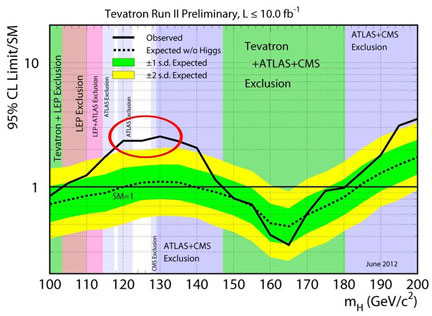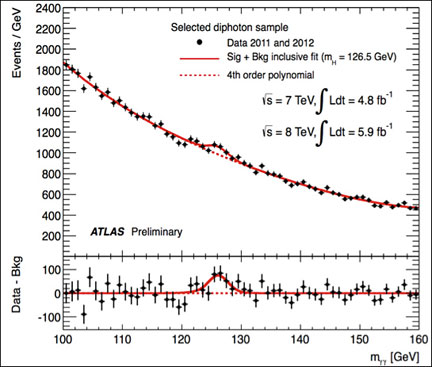Physicists from four experiments - two
at Fermi lab near Geneva, Illinois; and two at the LHC near Geneva,
Switzerland - announced discovering a new particle that could be the
long-sought Higgs Boson.
These experiments cannot yet determine what the new particle is; they have only determined its mass. This could be the Higgs or could be something else, which actually might be even more interesting.
What all these groups observed is an excess
of apparent particles with a mass of about 125 GeV (130 times heavier
than a proton). Here “excess” means more than expected based on the
Standard Model of particle physics. I say “apparent” because none of the
newly discovered particles were directly observed—they don’t live long enough to leave a detectable signal.
What the experimenters actually
observed were other well-known particles that do live long enough to be
detected, emanating from high-energy collisions. From the energies and
trajectories of the detected particles, experimenters found some
combinations that are consistent with the decay of a new particle of
mass 125 GeV. Since each of these high-energy collisions can produce
hundreds of particles, there are a myriad of possible combinations and
possible “new particle” masses. The key to claiming a discovery is to
establish an excess—more than expected—at a specific mass. The
discovery presumes that the Standard Model correctly predicts what would
be observed if the Higgs Boson did not exist.
The process sounds complex, and it is,
but fundamentally it is similar to examining a coin to find if it has a
hidden property. Flipping a normal coin would give heads 50% of the
time. If a certain coin comes up heads 75% of the time, the coin might
be special in some way. Statistics tells us how many times we have to
flip a coin to convincingly establish that it’s special.
The excess in the two American experiments have a 1-in-500 chance of being an accidental fluke.
The excess in the two European experiments have a 1-in-1 million chance of being an accidental fluke.
It is interesting that Fermi lab collected data from collisions between protons and antiprotons, whereas LHC collected data from proton-proton
collisions. The experiments are thus finding the new particle in
significantly different environments, adding to the credibility of its
existence.
While the Europeans have more convincing
data, we should acknowledge the contribution made by an American
high-energy particle accelerator. Since our accelerators have been shut
down, this may be the last important contribution made by American
fundamental physics labs for at least the next several decades.
More about why the Higgs is important can be found in my prior newsletter.
Below is the latest American data, with
the solid black line showing the measured particle masses and the dotted
line showing the expected masses without a Higgs Boson. The excess is
circled in red.

Below is the latest LHC-ATLAS data, with
the solid red line showing the measured particle masses and the dotted
line showing the expected masses without a Higgs Boson. The excess is
the bump at about 125 GeV.

Physicists have been searching for the
Higgs Boson for over 40 years. They convinced governments to spend over
$10 billion building the LHC to find the Higgs. So they are praying they
have found the 'God' particle, and are eager to celebrate. But
confirming that will take a lot more work.
Best Regards,
Robert
July 5, 2012
Note: Previous newsletters can be found on my website.
|